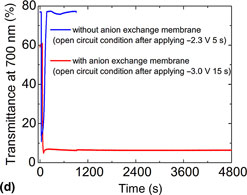Crossref Citations
This article has been cited by the following publications. This list is generated based on data provided by
Crossref.
Kimura, Shunsuke
Nakamura, Kazuki
and
Kobayashi, Norihisa
2020.
Bistable silver electrodeposition-based EC device with a Prussian blue counter electrode to maintain the mirror state without power supply.
Solar Energy Materials and Solar Cells,
Vol. 205,
Issue. ,
p.
110247.
Han, Jisu
Sung, Chihun
Song, Juhee
Ah, Chil-sung
Kim, Joo Yeon
Ryu, Hojun
Hwang, Chi-sun
and
Kim, Tae-Youb
2020.
Bistable mirror/transparent reversibly electrodeposited devices with TiO2 as the mediator.
Solar Energy Materials and Solar Cells,
Vol. 206,
Issue. ,
p.
110343.
Jang, Yeon Jae
Kim, Seon Yeong
Kim, Yong Min
Lee, Jae Kyeong
and
Moon, Hong Chul
2021.
Unveiling the diffusion-controlled operation mechanism of all-in-one type electrochromic supercapacitors: Overcoming slow dynamic response with ternary gel electrolytes.
Energy Storage Materials,
Vol. 43,
Issue. ,
p.
20.
Tao, Xin
Liu, Dongqing
Yu, Jinshan
and
Cheng, Haifeng
2021.
Reversible Metal Electrodeposition Devices: An Emerging Approach to Effective Light Modulation and Thermal Management.
Advanced Optical Materials,
Vol. 9,
Issue. 8,
Tsuneyasu, Shota
Kawara, Masashi
Enomoto, Koshin
Nakamura, Kazuki
and
Kobayashi, Norihisa
2021.
Reflective‐Emissive Representation by Combining Ru(II)‐Complex‐Based Electrochemiluminescence and Localized‐Surface‐Plasmon‐Resonance‐Based Electrochromism.
Advanced Materials Technologies,
Vol. 6,
Issue. 1,
Kobayashi, Norihisa
2022.
E‐Paper Displays.
p.
225.
Banasz, Radosław
Kubicki, Maciej
and
Wałęsa‐Chorab, Monika
2022.
Electrochemistry and Electrochromic Performance of a Metallopolymer Formed by Electropolymerization of a Fe(II) Complex with a Triphenylamine‐Hydrazone Ligand.
ChemPhysChem,
Vol. 23,
Issue. 4,
Tao, Xin
Liu, Dongqing
Liu, Tianwen
Meng, Zhen
Yu, Jinshan
and
Cheng, Haifeng
2022.
A Bistable Variable Infrared Emissivity Device Based on Reversible Silver Electrodeposition.
Advanced Functional Materials,
Vol. 32,
Issue. 32,
Liu, Yitong
Zhu, Xuehao
Yuan, Meng
Jiang, Xin
tang, Xin
Xu, Anqing
Wang, Yuhan
Yuan, Long
and
Duan, Yu
2023.
Silver reversible electrodeposition device under −40 °C condition.
Applied Physics Letters,
Vol. 123,
Issue. 25,
Wang, Jinhui
Lv, Ying
Zhou, Yiping
Jia, Sensen
Zhu, Feng
Schmidt, Oliver G.
and
Cai, Guofa
2024.
Electrolyte design for reversible metal electrodeposition-based electrochromic energy-saving devices.
APL Energy,
Vol. 2,
Issue. 1,
Yuan, Meng
Jiang, Xin
Liu, Yitong
Xu, Anqing
Tang, Xin
Wang, Xiaohua
Yuan, Long
and
Duan, Yu
2024.
NMP limits silver particle size to solve deposited film breakup problems.
AIP Advances,
Vol. 14,
Issue. 4,
Tong, Zhongqiu
Zhu, Xing
Xu, Hongbo
Li, Zhishan
Li, Shaoyuan
Xi, Fengshuo
Kang, Tianxing
Ma, Wenhui
and
Lee, Chun‐Sing
2024.
Multivalent‐Ion Electrochromic Energy Saving and Storage Devices.
Advanced Functional Materials,






